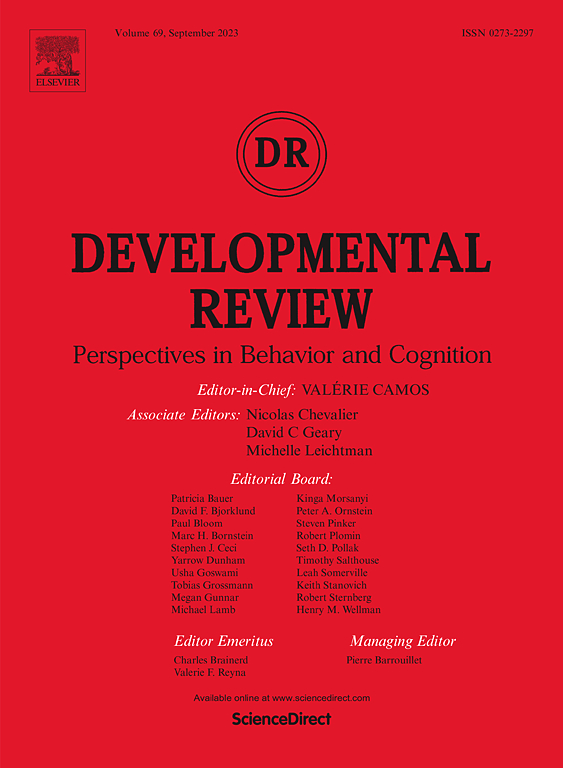模拟复杂跨表现:激活、注意能力和干扰
IF 5.6
1区 心理学
Q1 PSYCHOLOGY, DEVELOPMENTAL
引用次数: 0
摘要
复杂跨距任务是一种结合存储和处理要求的工作记忆测量方法。它们与执行注意力有关,并预测流体智力和在认知要求高的任务中的表现。复杂跨度性能的两个最突出的模型是基于时间的资源共享和盒中的串行顺序模型。前者假设了一个重新激活衰退记忆表征的刷新过程,而后者则是基于表征之间的干扰和干扰物的抑制。这两种模型都有优点,可以解释一些发现,但没有一个能提供完整的解释。我们提出了一个替代模型,该模型包括在建设性算子理论框架内的容量限制激活和干扰。我们的模型假设:(a)一个注意力资源激活了有限数量的任务相关信息单元(M容量,在发展过程中增加);(b)在刺激呈现过程中,该资源被用于激活备忘录表征以及编码和维持秩序的操作;(c)并发处理任务也使用M的容量份额;(d)超过M容量的备忘录陈述的激活在后续操作中减少,并且(e)在清单召回期间继续减少;(f)表征之间的干扰是激活减少的表征数量的幂函数;(g)完全激活的表征被正确地召回,部分激活的表征以特定的概率被检索。该模型包括一个自由参数(激活率下降,主要是由于干扰)和一个可以独立于其他任务估计的参数(M容量)。两个实验(一个针对成人,另一个针对10到13岁的儿童)支持这一模型,M能力大约占发育差异的一半。本文章由计算机程序翻译,如有差异,请以英文原文为准。
Modelling complex span performance: activation, attentional capacity, and interference
Complex span tasks, combining storage and processing requirements, are widely used working memory measures. They are related to executive attention and predict fluid intelligence and performance on cognitively demanding tasks. The two most prominent models of complex span performance are the Time-Based Resource Sharing and the Serial Order in a Box model. The former posits a refreshing process that re-activates decaying memory representations, whereas the latter is based on interference among representations and suppression of distractors. Both of these models have merits and can account for several findings, but none provides a complete explanation. We propose an alternative model that includes both capacity-limited activation and interference, framed within the Theory of Constructive Operators. Our model assumes: (a) an attentional resource activates a limited number (M capacity, increasing during development) of task-relevant information units; (b) during stimuli presentation this resource is used to activate representations of memoranda as well as encoding and order-keeping operations; (c) also the concurrent processing task uses a share of M capacity; (d) activation of the memoranda representations that exceed M capacity decreases over subsequent operations, and (e) continues decreasing during list recall; (f) interference among representations is a power function of the number of them whose activation is decreasing; (g) fully activated representations are recalled correctly, and partly activated representations are retrieved with a specified probability. The model includes one free parameter (rate of activation decrease, mainly due to interference) and one parameter (M capacity) that can be independently estimated from other tasks. Two experiments (one with adults and one with 10- to 13-year-olds) supported this model, and M capacity accounted for approximately half of the developmental variance.
求助全文
通过发布文献求助,成功后即可免费获取论文全文。
去求助
来源期刊

Developmental Review
PSYCHOLOGY, DEVELOPMENTAL-
CiteScore
11.00
自引率
3.00%
发文量
27
审稿时长
51 days
期刊介绍:
Presenting research that bears on important conceptual issues in developmental psychology, Developmental Review: Perspectives in Behavior and Cognition provides child and developmental, child clinical, and educational psychologists with authoritative articles that reflect current thinking and cover significant scientific developments. The journal emphasizes human developmental processes and gives particular attention to issues relevant to child developmental psychology. The research concerns issues with important implications for the fields of pediatrics, psychiatry, and education, and increases the understanding of socialization processes.
 求助内容:
求助内容: 应助结果提醒方式:
应助结果提醒方式:


